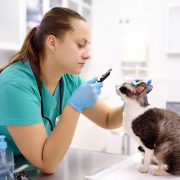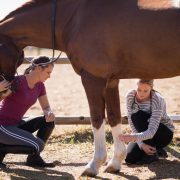Retrospective study: Laser excision versus combined laser, cryosurgery and intralesional 5-fluorouracil in the treatment of equine sarcoids
Retrospective study: Laser excision versus combined laser, cryosurgery and intralesional 5-fluorouracil in the treatment of equine sarcoids

our summary:
Offer, K.S. and Sutton, D.G.M. (2024) Retrospective study: Laser excision versus combined laser, cryosurgery and intralesional 5‐fluorouracil in the treatment of equine sarcoids. Equine Veterinary Education.
The aim of this retrospective case-controlled study was to compare two treatment protocols for equine sarcoids: laser excision alone and a combination protocol of laser excision, cryosurgery and 5-fluorouracil (5-FU) chemotherapy. In addition, factors associated with the recurrence of sarcoids were investigated. The authors hypothesised that the combination protocol would result in a lower sarcoid recurrence rate than laser excision alone.
The patient records of equids attending a UK equine hospital for the treatment of sarcoids between 2013-2022 were reviewed. Cases with histologically confirmed sarcoids that were treated by either of the treatment protocols under investigation were eligible for inclusion in the study. Data extracted from the records included case history and signalment, details of the lesion(s) including sarcoid type, location, number, dimensions, and volume, adverse events, response to treatment and sarcoid recurrence or occurrence of new lesions. Owners were contacted between August-October 2022, data collected included their animal’s history of sarcoid growth and treatment, outcome following treatment, regrowth of treated sarcoids and growth of any new sarcoids.
A total of 84 equids (80 horses and four donkeys) met the inclusion criteria, included cases had a total of 168 histologically confirmed individual sarcoids. Twenty-eight cases were treated by the combination protocol and 56 by laser excision alone. Follow up information was available for 73 cases, and 118 confirmed masses, median follow-up time was 39 months.
The overall incidence of recurrence of a sarcoid on an equid was 38%, for individual sarcoids the recurrence rate was 23%. There was no significant difference between treatment categories for sarcoid recurrence for any treated equid or individual sarcoid. Sarcoid recurrence was significantly higher in cases where sarcoid treatment had been received prior to initial presentation. Having a greater number of sarcoids and the surgical closure of any incision at the time of initial treatment were also associated with recurrence. More rapid recurrence was experienced in cases with urogenital sarcoids or >1 mixed sarcoid, recurrence was less rapid following the treatment of a horse’s first sarcoid.
Limitations of the study include the retrospective nature, and the inconsistent quality of the data contained within patient records. Additional limitations are owner recall bias, differing case populations and follow-up times between the treatment protocols, and that the results are from a single referral hospital so may not be applicable to other equine populations. There was no control population in the study.
This study provides some evidence that the characteristics of the patient and sarcoid(s) are more significant than the addition of adjunctive cryosurgery/chemotherapy in relation to sarcoid recurrence, therefore these should be carefully considered by veterinary practitioners when selecting treatment protocol.
The following may also be of interest:
inFOCUS: Treatment of equine sarcoids: a systematic review [RCVS Knowledge] [online] Available from: https://infocus.rcvsknowledge.org/treatment-of-equine-sarcoids-a-systematic-review/ [Accessed 18 October 2024]
Knottenbelt, D.C. (2019) The Equine Sarcoid: why are there so many treatment options. Veterinary Clinics of North America: Equine Practice, 35 (2), pp. 243-262. https://doi.org/10.1016/j.cveq.2019.03.006
Claiming CPD for reading inFOCUS articles
Reading and reflecting on articles can count towards your CPD, and we have a template to help you with the process.
Image copyright attribute: castenoid / 123RF Stock Photo










Leave a Reply
Want to join the discussion?Feel free to contribute!